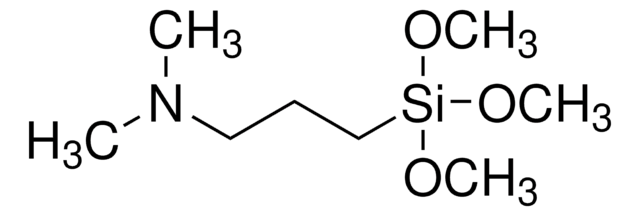440809
N-[3-(Trimethoxysilyl)propyl]aniline
Sinonimo/i:
Trimethoxy[3-(phenylamino)propyl]silane, (3-Anilinopropyl)trimethoxysilane, N-[3-(Trimethoxysilyl)propyl]aniline, [3-(Phenylamino)propyl]trimethoxysilane
About This Item
Prodotti consigliati
Stato
liquid
Livello qualitativo
Indice di rifrazione
n20/D 1.506 (lit.)
P. ebollizione
310 °C (lit.)
Densità
1.07 g/mL at 25 °C (lit.)
Stringa SMILE
CO[Si](CCCNc1ccccc1)(OC)OC
InChI
1S/C12H21NO3Si/c1-14-17(15-2,16-3)11-7-10-13-12-8-5-4-6-9-12/h4-6,8-9,13H,7,10-11H2,1-3H3
KBJFYLLAMSZSOG-UHFFFAOYSA-N
Cerchi prodotti simili? Visita Guida al confronto tra prodotti
Descrizione generale
Applicazioni
Avvertenze
Danger
Indicazioni di pericolo
Classi di pericolo
Aquatic Chronic 3 - Carc. 2 - Eye Dam. 1 - Muta. 2 - Skin Corr. 1B - Skin Sens. 1 - STOT RE 1
Organi bersaglio
Blood
Codice della classe di stoccaggio
6.1C - Combustible acute toxic Cat.3 / toxic compounds or compounds which causing chronic effects
Classe di pericolosità dell'acqua (WGK)
WGK 2
Punto d’infiammabilità (°F)
230.0 °F - closed cup
Punto d’infiammabilità (°C)
110 °C - closed cup
Scegli una delle versioni più recenti:
Possiedi già questo prodotto?
I documenti relativi ai prodotti acquistati recentemente sono disponibili nell’Archivio dei documenti.
I clienti hanno visto anche
Il team dei nostri ricercatori vanta grande esperienza in tutte le aree della ricerca quali Life Science, scienza dei materiali, sintesi chimica, cromatografia, discipline analitiche, ecc..
Contatta l'Assistenza Tecnica.






![Trimethoxy[3-(methylamino)propyl]silane 95%](/deepweb/assets/sigmaaldrich/product/structures/236/724/a4aa90e7-bf25-425f-9e44-cbc87ffac9fd/640/a4aa90e7-bf25-425f-9e44-cbc87ffac9fd.png)




